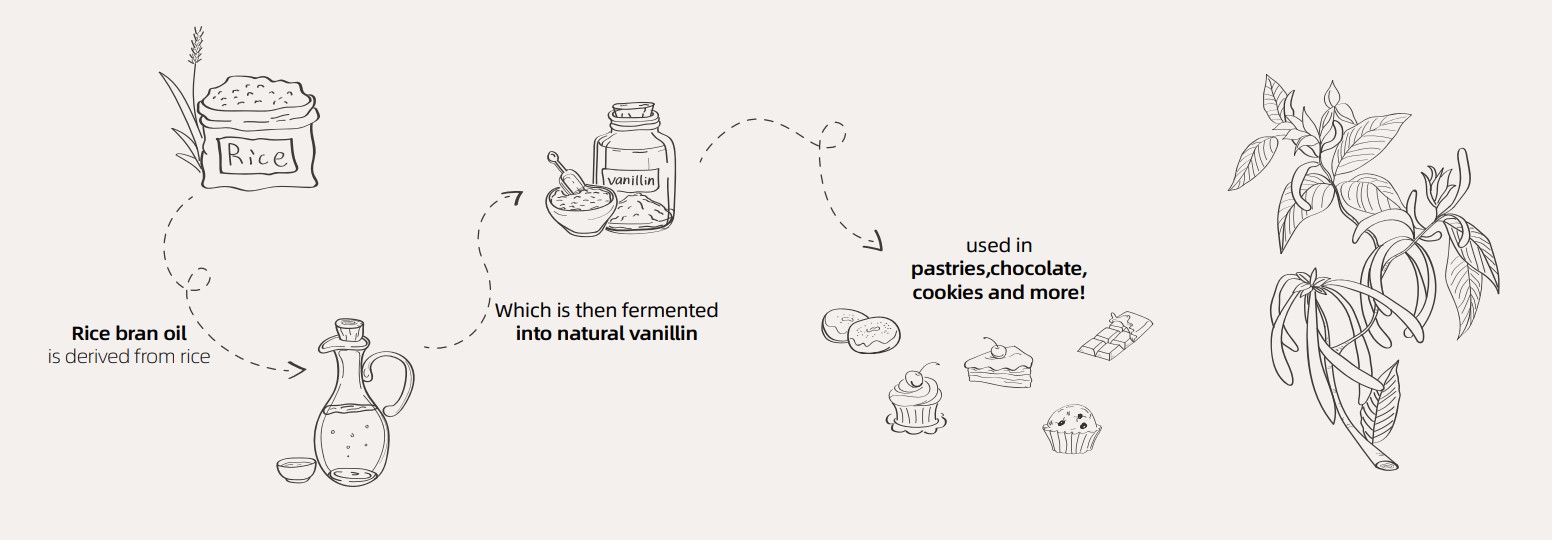Natural Vanillin
Natural Flavors and Fragrances
NATURAL SOURCED
Natural Vanillin is converted from natural sourced ferulic acid, which is commonly found in various plants,especially in grains like wheat, rice,andoats, as well as certain herbs.
NON-GENETICALLY MODIFIED
Strains responsible for Natural Vanillin production is natural sourced bacteria, which is free of contamination from genetically modified species.
PURITY AND AUTHENTICITY
Derived from the natural precursor ferulic acid, it avoids the synthetic pathways and chemical processes that define its counterpart. As a result, it preserves the integrity and complexity of natural flavors.
SUPERIOR AROMA
Natural vanillin has better flavor and texture. Natural vanillin delivers a better flavor when used in cooking or beauty products than the relatively one-dimensional characteristics of synthetic vanillin.
SUSTAINABLE SOURCING
Vanillin from ferulic acid is sourced from renewable and eco-friendly resources, reducing the ecological footprint of your culinary pursuits.
HEALTH-CONSCIOUS CHOICE
Vanillin from ferulic acid presents itself as a healthier alternative, offering a cleaner and more wholesome option for your culinary masterpieces.
General information
Natural Vanillin is one of the best-selling natural flavors and fragrances. It is a natural flavor, based on natural vanillin extracted from acid, providing an intense vanillin taste.
Natural vanillin has been widely used as a flavoring agent in various food and beverage products, as well as in perfumes and cosmetics.
Comparison to Chemical Extraction Technique

Reduced Land Consumption

Reduced Climate Impact

Reduced Energy Consumption
Natural Technical Routes
At present, there are many kinds of vanillin products on the market, and the common synthesized methods are as follows.
1st chemical technique
Petroleum
2-Methoxyphenol
Vanillin
Heavy Metal Catalysis
Our Technique
Rice Bran
Ferulic Acid
Natural Vanillin
GMO-free No Environmental Pollution Plant-based
2nd chemical technique
Clove Oil
Eugenol
Vanillin
Acid Environment
Compared to traditional methods of obtaining vanillin, manufacturing of Natural Vanillin is bio-based and involves no chemical process, which is eco-friendly and sustainable, with mild reaction conditions and reduced energy consumption.

Product Advantage
Natural Vanillin Highlights
Better Taste
Sustainable Supply
Clean Label
Environmentally Friendly
Natural Vanillin Specifications
| DETERMINATION | SPECIFICATION |
| IDENTIFICATION | |
Color State Fragrance | White to slightly yellow Crystals, usually needle-like Characteristic of vanilla aroma |
| ASSAY | |
| Vanillin(wt/wt% on dry basis) | ≥98% |
| TESTS | |
Melting point Loss on Drying Total Heavy Metals (as Pb) Arsenic (As) Cadmium (Cd) Mercury (Hg) Lead (Pb) | 81.0°C-83.0°C ≤0.15% ≤10.0mg/kg ≤3.0mg/kg ≤1mg/kg ≤1mg/kg ≤10mg/kg |
| PHYSICAL CHEMICAL PROPERTIES | |
pH (1% in water) Boiling point under 1.3kPa (9.75mmHg) Sublimation temperature Flash point (closed cup) Self-ignition Temperature vapour density (air = 1) (at 25°C) lsotopic ratio 13C/12C | 4.3 154°C 70°C 160°C-162°C 400°C minimum 5.3 -38‰/-35‰ |
| SOLUBILITY | |
In water In ethanol In ethyl acetate, methanol, diethyl ether | Slightly soluble (10g/l at 25℃) Freely soluble Soluble |